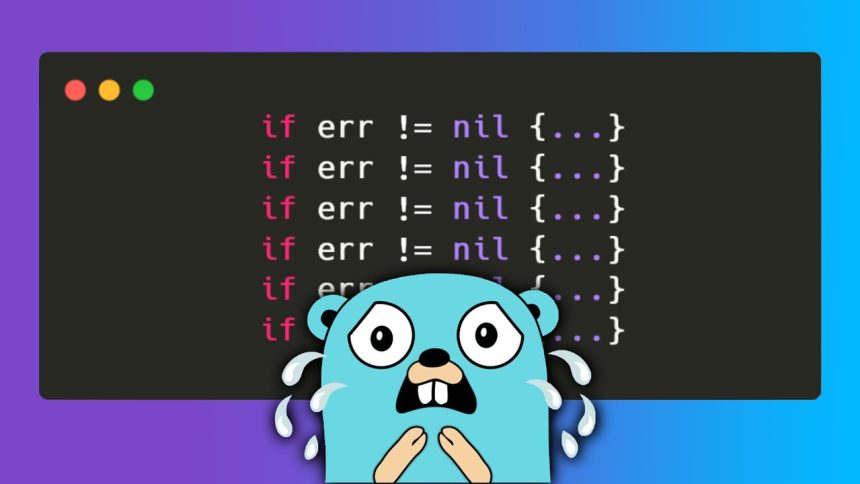
Introduction
In the realm of software development, the Go programming language (Golang) has garnered significant attention for its efficiency and simplicity. However, even the most elegant code can stumble upon errors. This is where proper error handling emerges as a critical aspect of Go programming, directly impacting the robustness and reliability of your applications. Effective error handling contributes not only to cleaner code but also to a smoother user experience by preventing unexpected crashes and providing informative error messages.
Key Highlights
- Learn about the significance of error handling in Go for writing reliable and maintainable applications.
- Understand the difference between returning error values, using panic and recover, and creating custom error types in Go.
- Explore advanced techniques like error wrapping to provide valuable context and simplify debugging.
- Discover how to log errors effectively for monitoring and diagnosing issues in your Go programs.
- Master the best practices and idiomatic ways to handle errors in your Golang projects.
Understanding Golang’s Error Handling Paradigm

Unlike many other programming languages that rely on exceptions, Golang takes a distinct approach to handling errors. Instead of throwing and catching exceptions, Go treats errors as values that are returned from functions alongside the regular return values. This paradigm shift promotes explicit error checking, forcing developers to acknowledge and address potential issues.
In essence, when a function encounters an error, it returns an error type alongside the expected result. This error type is an interface with a single method: Error() string. This method returns a human-readable error message. By convention, an error value of nil signifies the absence of any errors, while a non-nil error value indicates that something went wrong.
Why Effective Error Handling is Crucial in Go
In the world of software development, writing robust code is not just a preference—it’s a necessity. Effective error handling in Go plays a pivotal role in achieving this goal. When errors are handled gracefully, they transform from potential showstoppers into manageable situations. By anticipating and addressing errors, you build resilient applications that can withstand unexpected situations without crumbling.
Good error handling practices enhance code maintainability. As your codebase grows, tracking down the source of errors can become increasingly challenging. Clear error messages and well-defined error paths simplify debugging, allowing you and your team to identify and fix issues efficiently.
Moreover, prioritizing proper error handling from the outset often leads to a cleaner and more organized code structure. This focus on error management encourages you to think through different scenarios and design functions with potential issues in mind. The result is code that’s not only more reliable but also easier to understand and maintain over time.
The Role of the Built-in Error Interface
At the heart of Go’s error handling mechanism lies the built-in error interface. This simple yet powerful interface forms the foundation for representing and handling errors in an idiomatic Go way. Its definition is strikingly concise:
type error interface {
Error() string
}
This means that any type that implements the Error() string method can be considered an error in Go. This approach provides flexibility, allowing you to define custom error types tailored to your application’s needs.
The errors package in the Go standard library provides a convenient function, errors.New(string), for creating new errors. This function takes an error message as input and returns an error value. For instance, errors.New("something went wrong") constructs a new error with the specified message.
Implementing Error Handling: Core Strategies
Golang provides a straightforward yet powerful set of tools for handling errors effectively. By understanding these core strategies, you can equip your Go programs with the ability to gracefully handle unexpected situations and provide informative feedback.
Let’s explore these strategies to gain a deeper understanding of how to create robust and error-aware Go applications. From returning errors as function return values to leveraging custom error types, we’ll uncover the key practices that empower you to write resilient Go code.
Returning and Handling Errors in Go Functions
One of the most fundamental principles of error handling in Go is the practice of returning errors as function return values. This explicit approach ensures that error conditions are not overlooked and are handled proactively.
In Go, a function can return multiple values. By convention, the last return value of a function is often an error type. When a function encounters an error condition, it returns a non-nil error value along with any other return values.
Upon calling a function, it’s essential to check the returned error value. If the error is not nil, it indicates that an error occurred during the function call. For instance:
result, err := someFunction()
if err != nil {
// Handle the error appropriately
} else { // Proceed with using the 'result
}
Leveraging Multiple Return Values for Error Management
The power of multiple return values in Go extends beyond simple error handling. It empowers you to create more informative and context-aware error messages, enhancing the clarity and maintainability of your Go code.
Consider a scenario where a function might encounter multiple types of errors. By defining custom error types that implement the error interface, you can provide detailed insights into the nature of each error.
For example, you could have ValidationError for input validation issues, NotFoundError when a resource is not found, and InternalServerError for unexpected server-side problems. When returning errors, you can create new error values using these custom error types, providing specific information about the error condition.
Advanced Error Handling Techniques

As you progress in your Golang journey, mastering advanced error handling techniques becomes crucial for building robust and maintainable applications. These techniques go beyond the basics of returning error values, providing more context, structure, and flexibility in how you manage errors.
We’ll explore how to equip your code with the ability to not only handle errors gracefully but also convey valuable information about their causes and potential remedies.
Custom Error Types for Enhanced Control
Go’s built-in error interface provides a solid foundation for error handling, but sometimes you need more than a simple error message. Custom error types allow you to attach additional information to your errors, making them more informative and easier to handle in specific situations.
Imagine you’re building an API client, there are various types of errors that could occur, such as validation errors, authentication errors, or server errors. Each of these errors might require different handling logic. With custom error types, you can represent these errors in a way that your code can easily understand and act upon.
Here’s a simple example of defining a custom error type:
type APIError struct {
StatusCode int
Message string
}
func (e *APIError) Error() string {
return fmt.Sprintf("API error: %s (status code: %d)", e.Message, e.StatusCode)
}
Now, when handling errors from your API client, you can check for the specific error type and provide more tailored error messages or retry logic. This level of granularity can significantly enhance the maintainability of your error handling code.
The Significance of Error Wrapping in Go
Error wrapping, introduced in Go 1.13, is a valuable technique that allows you to add context to errors as they propagate up the call stack. This is particularly useful when you’re working with functions that call other functions, and you want to provide more information about where an error originated.
Think of error wrapping like adding layers of information to an error message, each layer representing a different level of the call stack. This approach ensures that when an error occurs deep within your code, you don’t just get a generic error message at the top level, instead, you receive a chain of errors that tell a more complete story.
Go provides the fmt.Errorf function with the %w verb for wrapping errors. For example:
if err != nil {
return fmt.Errorf("failed to read configuration file: %w", err)
}
The %w verb tells fmt.Errorf to wrap the original error (err) with the new error message. This creates a chain of errors where the original error is preserved, but additional context is added to it.
The Defer, Panic, and Recover Mechanism
While Go encourages explicit error handling by returning errors from functions, it also offers a mechanism for handling exceptional situations that might arise during program execution: the defer, panic, and recover trio.
These concepts are not meant to replace the standard error handling pattern. Instead, they provide a way to manage unrecoverable errors and unexpected conditions that might otherwise lead to abrupt program termination.
Using Defer to Clean Up Resources
The defer keyword is a powerful tool for ensuring that cleanup code, such as closing files or releasing resources, is always executed, regardless of whether a function returns normally or panics. When you use defer, the execution of the associated function call is postponed until the surrounding function exits.
Here’s how it works:
| Keyword | Description |
defer | Used to schedule a function call (deferred function) to be executed when the surrounding function exits. |
func processFile(filename string) error {
file, err := os.Open(filename)
if err != nil {
return fmt.Errorf("failed to open file: %w", err)
}
defer file.Close()
// Process the file
return nil
}
In this example, defer file.Close() ensures that the file is closed even if the function exits prematurely due to an error or a panic. This is crucial for preventing resource leaks.
Understanding Panic and Recover in Flow Control
In Go, a panic is a way to signal a fatal error that can’t be handled locally. It’s important to note that panics should be used sparingly, as they disrupt the normal flow of execution. When a panic occurs, the program begins unwinding the stack, running any deferred functions along the way.
recover allows you to intercept a panicking goroutine and stop the unwinding. It’s only useful inside deferred functions. During normal execution, a call to recover will return nil. However, if the current goroutine is panicking, recover will capture the value passed to panic and resume normal execution.
Here’s an example showcasing how panic and recover can be used together:
func handlePanic() {
if r := recover(); r != nil {
fmt.Println("Recovered from panic:", r)
}
}
func main() {
defer handlePanic()
// Some code that might panic
panic("something went wrong")
}
In this scenario, the handlePanic function attempts to recover from a panic. If successful, it will print a message indicating recovery. Otherwise, the program will terminate with a runtime crash, displaying the panic message.
Conclusion
Mastering error handling in Golang is essential for robust code. Understanding Go’s error handling paradigm and leveraging strategies like custom error types and error wrapping can elevate your error management skills. The defer, panic, and recover mechanism offers a safety net for exceptional scenarios. By implementing these best practices, you ensure code reliability and maintainability. Continuous learning and practice in error handling will refine your Golang programming expertise. Stay committed to mastering error handling for efficient and resilient Go applications.
Frequently Asked Questions
How do you create custom error messages in Go?
To create custom error messages in Go, you can use the fmt package’s Errorf function. As demonstrated in the first example, this function allows you to format error messages according to your requirements, providing clear and informative messages within your Go application.
Can defer statements be used to handle errors?
While defer statements are not designed for direct error handling, they play a crucial role in proper error handling within a Go program. They ensure that cleanup actions, such as closing resources, are performed by the deferred function regardless of whether an error occurs.
What is the importance of error wrapping in Go?
Error wrapping in Go, illustrated in the previous example using the %w verb, enhances error messages by adding context to them. By wrapping errors, you provide a more informative trace of how an error occurred, making it easier to debug and understand the flow of events in your Go code.



